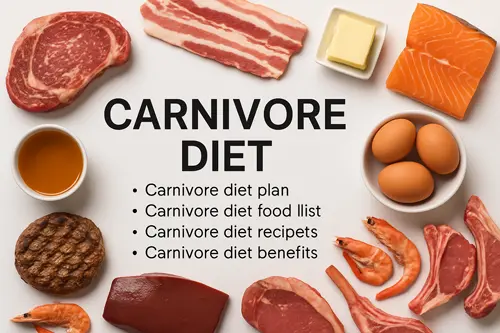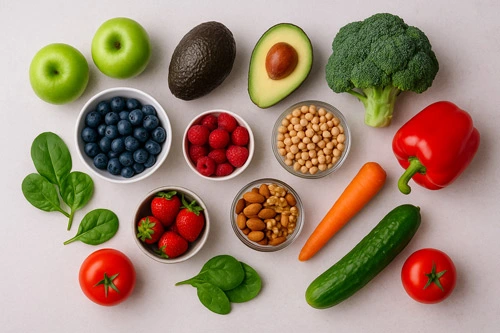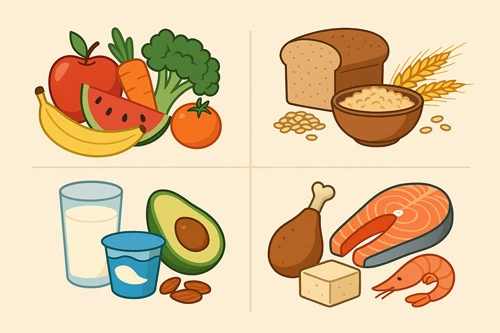Introduction
The Carnivore Diet has emerged as one of the most controversial and talked-about eating patterns in recent years. At its core, this diet consists entirely of animal-based foods—primarily meat, fish, eggs, and animal fats—while completely eliminating all plant-based ingredients, including fruits, vegetables, grains, and legumes. For some, this radical shift represents a return to our ancestral roots; for others, it’s a powerful tool to overcome autoimmune issues, digestive disorders, and even stubborn weight gain.
As more people explore alternative diets to improve their health, the carnivore lifestyle is gaining attention for its simplicity, satiety, and surprising results. But is it really sustainable? What are the long-term benefits and potential risks? In this article, we’ll take a deep dive into the carnivore diet plan, including the approved food list, beginner-friendly meal ideas, expert-backed benefits, side effects to watch out for, and real-life success stories.
Whether you’re curious about going zero-carb or comparing it to other low-carb approaches like keto, this guide is designed to answer your most pressing questions and help you decide if the carnivore way of eating is right for you.
🥩 1. What Is the Carnivore Diet?
The Carnivore Diet is a high-protein, zero-carb dietary approach that centers exclusively on animal-based foods. This means eliminating not only processed and sugary items but also cutting out fruits, vegetables, grains, legumes, nuts, and seeds entirely. It’s often described as an “all-meat diet,” although it can include other animal-derived foods like eggs, fish, bone broth, and even dairy (depending on the level of strictness).
While it may seem extreme at first glance, proponents argue that this way of eating mimics the dietary habits of early humans, who relied heavily on animal foods for survival. The idea is that the human body thrives on nutrient-dense animal products and doesn’t actually require plant-based foods to function optimally.
🔸 Origins and Evolution
Although the carnivore diet has gained mainstream attention in the last decade, the concept isn’t new. Indigenous populations like the Inuit and Maasai have long followed animal-based diets with minimal plant intake. Modern interest in this diet has surged thanks to high-profile advocates such as Dr. Shawn Baker and psychologist Jordan Peterson, who credit the diet with improving their mental and physical health.
Unlike ketogenic diets, which aim to keep carbohydrate intake below a certain threshold (usually under 50 grams per day), the carnivore diet aims for zero carbs. There’s no room for “cheat days” or carb cycling—it’s all about consuming meat, day in and day out.
🔸 Carnivore Diet vs. Other Diets
When comparing the carnivore diet vs keto, the differences become clear:
| Feature | Carnivore Diet | Keto Diet |
|---|---|---|
| Carb Intake | Zero (0 grams) | Low (typically under 50g/day) |
| Plant Foods | Eliminated entirely | Allowed in moderation |
| Food Variety | Very limited (meat-focused) | Moderate (meat, fats, veggies) |
| Ketosis | Yes, due to no carbs | Yes, due to low carbs |
| Simplicity | Very simple | More complex (requires tracking) |
The carnivore diet removes the guesswork. There’s no need to track macros or worry about meal timing—just eat animal-based foods when you’re hungry, and stop when you’re full.
🔸 Why People Choose the Carnivore Diet
Supporters of the carnivore diet report a wide range of health improvements, such as:
-
Rapid fat loss and reduced cravings
-
Improved mental clarity and mood stability
-
Better digestion and relief from bloating or IBS
-
Reduction in autoimmune symptoms
-
Clearer skin and decreased inflammation
It’s especially appealing to people who have tried multiple diets without success, or those with food sensitivities who feel better when eliminating complex plant compounds like lectins, oxalates, and gluten.
However, despite these benefits, it’s important to note that this diet is still controversial among nutrition experts. Critics argue that the lack of fiber, antioxidants, and plant-based micronutrients could pose long-term health risks. That’s why careful monitoring, blood work, and ideally, professional supervision are strongly recommended.
learn more: Renal Diet: Guide to Meals, Restrictions & Foods to Avoid
🥩 2. Carnivore Diet Plan: How to Get Started
Transitioning to a carnivore diet may sound simple—just eat meat and skip everything else—but for many beginners, it can be a significant lifestyle shift. Without proper planning, you may experience unnecessary discomfort, nutritional imbalances, or even early burnout. This section will walk you through how to start the carnivore diet safely and effectively, whether you’re a complete beginner or transitioning from a keto or low-carb lifestyle.
🔹 2.1 Start with a Clean Slate
Before diving into a full carnivore approach, it’s important to clear your pantry and prepare your body and mind for the change. Remove temptations like bread, snacks, sugary drinks, and plant-based oils. Stock up on:
-
Grass-fed beef (ground beef, steaks)
-
Pasture-raised eggs
-
Chicken thighs or drumsticks
-
Organ meats (like liver)
-
Wild-caught fish and seafood
-
Animal fats (tallow, butter, lard)
-
Bone broth (for hydration and minerals)
If you’re coming from a high-carb diet, consider transitioning gradually to avoid carb withdrawal symptoms like headaches, fatigue, and irritability.
🔹 2.2 Carnivore Diet for Beginners: Key Tips
Starting the carnivore diet for beginners involves learning a few ground rules:
-
Eat until you’re full – don’t count calories.
-
Stick to simplicity – don’t complicate meals; meat, salt, and water are enough.
-
Stay hydrated – drink plenty of water and consider adding electrolytes.
-
Be patient – your body may take 2–4 weeks to fully adapt.
-
Listen to your body – eat when hungry; rest when tired.
Some people also include “transition foods” like cheese, heavy cream, or coffee, especially in the early weeks. While not part of the strict carnivore protocol, they can make the shift easier.
🔹 2.3 Different Levels of Carnivore
There are varying degrees of strictness in the carnivore community:
| Type | Description |
|---|---|
| Strict Carnivore | Only animal meat, water, and salt |
| Relaxed Carnivore | Includes dairy, eggs, coffee, and spices |
| Zero-Carb | Focus on zero-carb, but may allow processed meats |
| Lion Diet | Beef, salt, and water only (popularized by Mikhaila Peterson) |
Choose the version that works best for your health goals and lifestyle.
🔹 2.4 Sample 7-Day Carnivore Diet Meal Plan
Here’s a beginner-friendly meal plan that keeps things simple and satisfying:
| Day | Breakfast | Lunch | Dinner |
|---|---|---|---|
| 1 | Scrambled eggs with bacon | Grilled ribeye steak | Ground beef patties |
| 2 | Hard-boiled eggs & liver | Chicken thighs (pan-fried) | Pork chops |
| 3 | Black coffee & boiled eggs | Salmon fillet (baked) | Lamb ribs |
| 4 | Omelet with cheese | Beef liver and onions | Roast chicken |
| 5 | Sausage (sugar-free) | Tuna with mayo | Ribeye steak |
| 6 | Steak and eggs | Sardines in olive oil | Duck breast |
| 7 | Fasting or bone broth | Chicken drumsticks | Grilled sirloin |
This plan is flexible—feel free to repeat meals, eat leftovers, or skip breakfast if you’re not hungry. Many carnivore followers find that intermittent fasting (e.g., 16:8) happens naturally as appetite regulation improves.
🔹 2.5 Supplements and Electrolytes
While the carnivore diet provides most nutrients, some people may need support:
-
Electrolytes: sodium, potassium, magnesium (especially in early adaptation)
-
Vitamin D: if you’re not exposed to sunlight
-
Omega-3s: especially if you eat little seafood
-
Digestive enzymes: can help with fat/meat digestion during transition
Always consult a healthcare provider before starting supplementation, especially if you have underlying health conditions.
learn more: Hashimoto Diet: Your Essential Guide to Thyroid Health
3. Carnivore Diet Food List: What You Can and Cannot Eat
One of the biggest appeals of the Carnivore Diet is its simplicity. You don’t need to count calories, track macros, or weigh your food. However, it’s essential to understand which foods are allowed and which ones must be avoided to stay in line with the diet’s core principles.
While some people follow a very strict version that includes only red meat and salt, others adopt a more flexible approach that incorporates dairy, eggs, and even coffee.
🔹 3.1 Foods You Can Eat on the Carnivore Diet
The following foods are 100% approved and form the core of most carnivore meal plans:
| Category | Examples |
|---|---|
| Red Meat | Beef (steak, ground beef, ribs), lamb, veal |
| Poultry | Chicken (thighs, wings, drumsticks), turkey, duck |
| Seafood | Salmon, sardines, shrimp, tuna, mackerel |
| Eggs | Whole eggs (pasture-raised preferred) |
| Animal Fats | Tallow, lard, suet, duck fat, butter (if tolerated) |
| Organ Meats | Liver, kidney, heart, tongue, bone marrow |
| Bone Broth | Homemade or clean ingredient versions |
| Salt & Seasonings | Unrefined sea salt, pepper (optional for flexible followers) |
Optional additions (depending on your version of the diet):
-
Hard cheeses (like cheddar, Parmesan)
-
Heavy cream or full-fat dairy
-
Black coffee or tea (not strict carnivore)
🔹 3.2 Foods to Avoid on the Carnivore Diet
Anything that grows from the ground—or is processed with added sugars, preservatives, or carbs—is generally off-limits:
| Category | Examples |
|---|---|
| Fruits & Vegetables | Apples, bananas, spinach, broccoli, carrots |
| Grains | Wheat, rice, oats, corn, barley |
| Legumes | Beans, lentils, peas, soy products |
| Sugar & Sweeteners | Table sugar, honey, agave, stevia, aspartame |
| Seed Oils | Canola, soybean, sunflower, corn oil |
| Nuts & Seeds | Almonds, peanuts, flaxseed, chia |
| Processed Foods | Sausages with fillers, cured meats with sugar, frozen dinners |
Even common keto-friendly foods like avocados, almond flour, or olive oil are not allowed in a strict carnivore plan.
🔹 3.3 Strict Carnivore vs. Modified Carnivore
Not all carnivore followers adhere to the same rules. Here’s a comparison to help you decide which version fits your goals:
| Feature | Strict Carnivore | Modified Carnivore |
|---|---|---|
| Plant Foods | None | Occasional (coffee, herbs) |
| Dairy | Excluded | Optional (cheese, cream) |
| Seasonings | Only salt | Includes basic spices |
| Processed Meats | Avoided | Sometimes allowed if clean |
| Focus | Beef, water, salt | Broader variety of animal foods |
If you’re aiming for maximum elimination—for example, to reduce inflammation or test for food sensitivities—strict carnivore is ideal. If you’re seeking a high-protein, low-carb lifestyle with more flexibility, modified carnivore may be easier to sustain.
🔹 3.4 Grocery Shopping Tips
When shopping for carnivore-approved foods, keep these tips in mind:
-
Buy in bulk for meats—look for deals on whole cuts or ground beef.
-
Read labels on packaged meats to avoid hidden carbs or sugars.
-
Prioritize quality—grass-fed and pasture-raised is ideal, but not mandatory.
-
Stock up on salt—you’ll need more sodium than usual on this diet.
By keeping your food list simple and clean, the carnivore diet can become a sustainable and deeply nourishing way of eating. In the next section, we’ll explore how to prepare satisfying carnivore diet recipes that keep meals exciting and enjoyable.
🍳 4. Carnivore Diet Recipes: Easy & Delicious Ideas
One of the biggest misconceptions about the carnivore diet is that it’s boring or repetitive. In reality, once you understand how to prepare meat-based meals creatively, you’ll find it both satisfying and surprisingly diverse. Whether you’re following a strict protocol or a flexible carnivore diet plan, having go-to recipes can help you stay consistent and avoid burnout.
In this section, you’ll discover quick, beginner-friendly carnivore diet meals you can rotate throughout the week—no fancy equipment or cooking skills needed!
🔹 4.1 Carnivore Diet Breakfast Recipes
While many carnivore followers skip breakfast due to intermittent fasting, others enjoy starting their day with a high-fat, protein-rich meal.
🥓 1. Classic Steak & Eggs
-
1 ribeye steak, grilled or pan-seared
-
2-3 pasture-raised eggs, fried in beef tallow
-
Sprinkle with sea salt
This simple combo is perfect for energy and satiety—and it fits perfectly into any carnivore diet meal plan.
🧈 2. Butter-Fried Liver & Eggs
-
Slices of beef liver (lightly cooked in butter)
-
Scrambled eggs on the side
-
Great for iron, B12, and essential nutrients
🔹 4.2 Lunch Ideas for the Carnivore Diet
Midday meals should be nutrient-dense and satisfying to keep your energy up.
🍗 1. Crispy Chicken Thighs
-
Skin-on, bone-in thighs baked with salt and duck fat
-
Optional: top with melted butter
🐟 2. Salmon with Bone Broth
-
Pan-seared wild-caught salmon
-
Served with a warm cup of homemade bone broth
-
Rich in omega-3s and collagen
🔹 4.3 Dinner Recipes on the Carnivore Diet
Dinner is often the largest meal of the day on a meat-based diet. Here are a few hearty favorites:
🐄 1. Ground Beef Bowls
-
80/20 ground beef, pan-fried with sea salt
-
Add bone marrow or egg yolks for richness
-
Serve hot in a bowl with melted cheese (optional for modified carnivore)
🥩 2. Slow-Cooked Short Ribs
-
Beef short ribs cooked in a slow cooker with bone broth and salt
-
Meat becomes tender and flavorful after 6–8 hours
🔹 4.4 Snack & Prep-Friendly Recipes
Snacking isn’t always necessary on the carnivore lifestyle, but for those who need quick bites, these recipes are ideal:
🧀 1. Cheese Crisps (if tolerated)
-
Shredded aged cheese baked until crisp
-
Store in airtight container
🥓 2. Homemade Beef Jerky
-
Thin slices of beef marinated in salt, dehydrated or baked
-
Sugar-free and perfect for travel
🔹 4.5 Cooking Tips for Carnivore Diet Beginners
If you’re new to meat-based cooking, here are some tips:
-
Use animal fats generously for cooking (tallow, ghee, butter)
-
Don’t overcook meats—keep them juicy for better flavor and digestion
-
Prep in batches—cook several meals at once and store leftovers
-
Organ meats can be blended into ground beef if the taste is too strong
-
Salt is your friend—your body needs more sodium on this diet
🔹 4.6 Tools That Make Carnivore Cooking Easier
-
Cast iron skillet – perfect for steaks and eggs
-
Slow cooker or Instant Pot – great for ribs and roasts
-
Meat thermometer – avoid overcooking
-
Vacuum sealer – for batch prepping and freezing meats
By exploring these easy carnivore diet recipes, you’ll discover that following a meat-based way of eating doesn’t mean sacrificing variety or flavor. As your palate adapts, you’ll find deeper appreciation for the natural taste of high-quality animal foods.
In the next section, we’ll look at the science-backed benefits of the carnivore diet and why so many people are turning to this radical approach for better health.
✅ 5. Benefits of the Carnivore Diet
The carnivore diet has gained popularity not just for its simplicity, but for the powerful benefits many users report after switching to this all-animal-based way of eating. While scientific research is still catching up with anecdotal evidence, thousands of followers—especially beginners—share remarkable improvements in weight, mood, energy, and even chronic health conditions.
Let’s explore the top carnivore diet benefits that have convinced many people to abandon traditional nutrition advice and embrace a meat-only lifestyle.
🔹 5.1 Rapid Weight Loss
One of the most common reasons people try the carnivore diet for weight loss is its powerful fat-burning effect. By eliminating carbohydrates, the body shifts into a fat-adapted state, using stored body fat for fuel.
-
No need to count calories
-
Increased satiety from high-protein, high-fat meals
-
No blood sugar spikes or crashes
Many people report losing stubborn fat effortlessly, especially in the belly and waist area.
🔹 5.2 Reduced Inflammation and Joint Pain
Inflammation is at the root of many chronic conditions, from arthritis to autoimmune disorders. By removing processed foods, sugar, and inflammatory plant compounds (like lectins and oxalates), the carnivore diet often provides fast relief.
-
Reduced joint stiffness
-
Fewer flare-ups in autoimmune diseases
-
Improved recovery after workouts
These effects are commonly seen in carnivore diet before and after testimonials.
🔹 5.3 Improved Mental Clarity and Mood
Many carnivore diet reviews describe dramatic improvements in mood, focus, and energy levels. This may be due to:
-
Stable blood sugar (no carb crashes)
-
Reduction in gut inflammation (which impacts brain health)
-
Higher intake of essential brain nutrients like B12, omega-3s, and cholesterol
People with anxiety, depression, or brain fog often feel sharper and calmer within weeks of starting.
🔹 5.4 Better Digestion and Gut Health
It may sound counterintuitive, but cutting out fiber can actually improve digestion for many people—especially those with bloating, IBS, or food sensitivities.
-
Fewer bowel issues (like constipation or diarrhea)
-
Reduced bloating and gas
-
Simpler digestion with fewer food triggers
The carnivore diet for beginners often starts with simplified meals that are easier on the gut.
🔹 5.5 Clearer Skin and Fewer Allergies
Skin conditions like acne, eczema, and rosacea often improve dramatically on a carnivore diet. This is likely due to:
-
Removing dairy (in strict versions) and sugar
-
Cutting inflammatory plant compounds
-
Supporting skin health with collagen, zinc, and vitamin A from organ meats
Allergies and seasonal sensitivities may also decrease thanks to the anti-inflammatory effects.
🔹 5.6 More Energy and Less Craving
High-fat, animal-based meals provide lasting energy without the highs and lows caused by sugar. Many users find:
-
No more constant snacking
-
No cravings for sweets or junk food
-
Consistent energy throughout the day
This is especially important for people who have struggled with yo-yo dieting and emotional eating.
🔹 5.7 Simple and Sustainable Eating
One of the underrated benefits of the carnivore diet is its simplicity:
-
No complex recipes or shopping lists
-
Easy meal prep
-
Minimal decision fatigue around food
For many, this minimalist approach leads to long-term adherence and lifestyle change.
These carnivore diet benefits aren’t just theoretical—they’re echoed by countless testimonials from Reddit, YouTube, and blogs worldwide. However, as we’ll see in the next section, this way of eating isn’t without its downsides.
Up next, we’ll cover the potential side effects of the carnivore diet and how to manage them—especially if you’re just getting started.
learn more: Anti Inflammation Diet: Best Foods, Recipes, and Plans to Fight Inflammation
🥩 What is the Carnivore Diet?
The Carnivore Diet is a strict form of an all-animal food eating plan that focuses exclusively on consuming meat, fish, animal fats, and sometimes eggs and dairy. This means eliminating all plant-based foods—including vegetables, fruits, grains, legumes, nuts, and seeds—from the daily menu. It’s often described as the opposite of a plant-based or vegan diet.
Unlike other low-carb or ketogenic diets that still include vegetables and limited fruits, the carnivore diet plan emphasizes zero carbohydrates, making it the most restrictive variation of low-carb eating. While that may sound extreme, supporters argue that this approach can drastically improve health, particularly for those with autoimmune diseases, inflammation, gut issues, and even mental health conditions.
For beginners, transitioning to the carnivore diet may seem overwhelming at first. However, the simplicity of the diet is actually one of its greatest advantages: there’s no need to count calories, track macros, or worry about food combining. You simply choose items from the carnivore diet food list, which generally includes:
-
Red meat (beef, lamb, venison, etc.)
-
Poultry (chicken, duck, turkey)
-
Fish and seafood
-
Eggs
-
Animal-based fats (tallow, lard, butter)
-
Organ meats (liver, kidney, heart)
-
Optional: dairy (cheese, heavy cream) if tolerated
The logic behind this eating pattern stems from the belief that human ancestors primarily consumed animal-based foods and that our digestive systems are better adapted to this type of fuel. By eliminating plant foods—many of which contain anti-nutrients, fiber, and compounds that some people may react to—the carnivore diet aims to reduce digestive stress and promote metabolic healing.
In the next sections, we’ll explore what a typical carnivore diet meal plan looks like, the benefits and side effects of this diet, and how it compares to other approaches like keto.
🥓 Carnivore Diet Food List
One of the biggest advantages of the carnivore diet for beginners is its simplicity. You don’t have to weigh portions, track calories, or worry about complex recipes. Instead, your focus is on choosing foods that come exclusively from animals. The following is a complete carnivore diet food list to help you get started.
✅ 1. Red Meat (The Foundation)
Red meat is the core of any carnivore diet meal plan. It provides high-quality protein, iron, zinc, and vital nutrients such as vitamin B12 and creatine.
-
Beef: ribeye, ground beef, steak, brisket, roast
-
Lamb: chops, ground lamb, shoulder
-
Venison and other wild game
Grass-fed or pasture-raised meat is often recommended for better nutrient profiles, but it’s not mandatory.
✅ 2. Poultry
While poultry is leaner than red meat, it’s still an acceptable option and offers variety.
-
Chicken: thighs, wings, breast (preferably with skin)
-
Duck: especially rich in fat
-
Turkey: good for leaner meals
✅ 3. Fish and Seafood
Including fish offers omega-3 fatty acids, which have anti-inflammatory properties.
-
Salmon (wild-caught is ideal)
-
Sardines
-
Mackerel
-
Tuna
-
Shellfish: shrimp, scallops, oysters, mussels
✅ 4. Eggs
Eggs are one of the most nutrient-dense foods available. They contain nearly every vitamin and mineral the human body needs, especially when you consume the yolk.
-
Chicken eggs (most common)
-
Duck eggs (richer in fat)
-
Quail eggs
Many carnivore diet recipes use eggs as a base ingredient for breakfast or snacks.
✅ 5. Organ Meats (Nature’s Multivitamin)
Organ meats are optional but highly recommended due to their dense nutritional content.
-
Liver (rich in vitamin A, iron)
-
Kidney (excellent source of selenium)
-
Heart (rich in CoQ10)
-
Bone marrow
Eating organ meats once or twice per week can significantly boost your nutrient intake on the carnivore diet plan.
✅ 6. Animal-Based Fats
Fat is essential on the carnivore diet because it’s your main energy source. Unlike carbs, fat is burned slowly and keeps you satiated.
-
Tallow (rendered beef fat)
-
Lard (rendered pork fat)
-
Butter (if tolerated)
-
Bone broth (rich in collagen and minerals)
✅ 7. Optional: Dairy Products
While purists avoid dairy, many beginners include it as a transition food. However, it’s best to choose full-fat, low-lactose dairy products.
-
Aged cheeses (cheddar, gouda, parmesan)
-
Heavy cream
-
Ghee (clarified butter)
If you experience digestive issues, acne, or bloating, consider removing dairy to see if symptoms improve.
🍖 4. Carnivore Diet Meal Plan: 7-Day Example
Starting a new diet can be overwhelming, especially one as restrictive as the carnivore diet. That’s why having a simple and practical carnivore diet meal plan can make the transition much easier for beginners. Below is a 7-day sample meal plan that focuses on variety, nutrient density, and ease of preparation.
🔹 Day 1
-
Breakfast: Ribeye steak with fried eggs
-
Lunch: Ground beef patties seasoned with salt
-
Dinner: Baked salmon with bone broth
🔹 Day 2
-
Breakfast: Scrambled eggs cooked in butter
-
Lunch: Grilled chicken thighs with skin
-
Dinner: Slow-cooked beef short ribs
🔹 Day 3
-
Breakfast: Beef liver sautéed in tallow
-
Lunch: Tuna salad (tuna mixed with homemade mayonnaise from egg yolks and animal fat)
-
Dinner: Roasted pork chops
🔹 Day 4
-
Breakfast: Omelet with cheese (optional)
-
Lunch: Shrimp cooked in butter
-
Dinner: Lamb chops with bone marrow
🔹 Day 5
-
Breakfast: Hard-boiled eggs
-
Lunch: Beef heart grilled or pan-fried
-
Dinner: Duck breast with crispy skin
🔹 Day 6
-
Breakfast: Sausages (sugar-free, natural)
-
Lunch: Sardines with melted butter
-
Dinner: Ribeye steak with bone broth
🔹 Day 7
-
Breakfast: Fasting or bone broth only (optional)
-
Lunch: Chicken drumsticks roasted with skin
-
Dinner: Ground beef meatballs (made with egg and salt)
🔹 Tips for Success on Your Carnivore Diet Meal Plan
-
Drink plenty of water throughout the day.
-
Add salt liberally to support electrolyte balance.
-
Don’t be afraid to eat until you feel satisfied—this diet naturally regulates hunger.
-
If you’re new, start slow and gradually increase the amount of meat.
-
Consider intermittent fasting as your appetite adjusts.
This sample carnivore diet meal plan is designed to provide ample protein, fats, and essential nutrients to keep you energized and satisfied. As you become more familiar with the diet, feel free to customize meals based on your preferences and availability.
✅ 5. Benefits of the Carnivore Diet
The carnivore diet has attracted many followers due to the impressive benefits reported by both beginners and experienced adherents alike. While scientific research is still evolving, anecdotal evidence and preliminary studies suggest that this meat-based eating pattern can support various aspects of health and wellbeing.
Here are some of the top carnivore diet benefits:
🔹 5.1 Effective Weight Loss
One of the most common reasons people try the carnivore diet for beginners is its ability to promote rapid fat loss. By eliminating carbohydrates and focusing on satiating animal proteins and fats, the body enters a state of fat-burning called ketosis, which supports consistent weight reduction without hunger.
🔹 5.2 Reduced Inflammation
Many individuals experience a significant decrease in inflammation-related symptoms, such as joint pain, skin issues, and autoimmune flare-ups. This benefit is largely due to removing inflammatory plant compounds and processed foods from the diet.
🔹 5.3 Improved Mental Clarity and Mood
Stable blood sugar levels and the high nutrient density of animal foods may contribute to enhanced cognitive function, better focus, and mood stabilization. Some users report relief from brain fog and anxiety.
🔹 5.4 Enhanced Digestion
Despite the lack of fiber, many people find their digestion improves on the carnivore diet. Common issues like bloating, gas, and IBS symptoms often diminish, possibly due to the elimination of difficult-to-digest plant fibers and anti-nutrients.
🔹 5.5 Increased Energy and Reduced Cravings
High-fat and protein-rich meals provide long-lasting energy, reducing the need for frequent snacking and minimizing sugar cravings.
🔹 5.6 Simplified Eating Habits
The carnivore diet’s simplicity reduces decision fatigue and makes meal planning easy, contributing to sustainable healthy habits.
These benefits have encouraged many to share positive carnivore diet reviews on platforms like Reddit and health forums, showing real-world success stories from beginners and long-term followers alike.
⚠️ 6. Carnivore Diet Side Effects & Challenges
While many people experience significant benefits from the carnivore diet, it’s important to be aware of potential side effects and challenges—especially for those new to this way of eating.
🔹 6.1 Common Side Effects
Some individuals report mild to moderate symptoms during the initial adaptation phase, often called the “keto flu” or “carnivore flu,” which may include:
-
Fatigue and weakness
-
Headaches
-
Brain fog
-
Nausea
-
Dizziness or lightheadedness
-
Digestive changes like constipation or diarrhea
These symptoms usually resolve within a few days to weeks as your body adapts to burning fat for fuel instead of carbohydrates.
🔹 6.2 Nutritional Concerns
Since the carnivore diet excludes all plant foods, some people worry about missing out on important vitamins, minerals, and fiber. Although animal products provide many nutrients, you might need to monitor:
-
Vitamin C — Found mostly in fruits and vegetables but in small amounts in organ meats. Some carnivore followers use supplements if needed.
-
Fiber — Lack of fiber may affect gut microbiota diversity, though many report improved digestion.
-
Magnesium and potassium — Important electrolytes that may need supplementation during early stages.
🔹 6.3 Social and Practical Challenges
Eating only animal products can make social dining, traveling, and grocery shopping more difficult. It requires planning and commitment, which can be challenging in many cultural contexts.
🔹 6.4 Potential Long-Term Risks
While short-term results are promising, long-term studies on the carnivore diet are limited. Potential risks may include:
-
Elevated cholesterol and heart disease risk in susceptible individuals
-
Nutrient imbalances if the diet is not well planned
-
Gut microbiome changes that are not yet fully understood
It’s crucial to work with a healthcare professional if you plan to follow this diet long-term, especially if you have pre-existing health conditions.
🔹 6.5 Tips to Manage Side Effects
-
Stay well hydrated and consume enough salt to maintain electrolyte balance.
-
Gradually transition into the diet rather than making a sudden switch.
-
Include a variety of animal foods, including organ meats, to maximize nutrient intake.
-
Monitor your health regularly with blood tests.
Despite these challenges, many people adapt successfully and find the carnivore diet for beginners to be a powerful tool for health improvement. Listening to your body and seeking professional guidance can help make the experience safer and more enjoyable.
⚡️ 7. What Happens if You Eat Carbs on the Carnivore Diet?
For those following the strict carnivore diet plan, the idea is to consume zero carbohydrates by eating only animal-based foods. However, life isn’t always perfect, and sometimes people wonder: What happens if you eat carbs on the carnivore diet? Whether it’s intentional or accidental, adding carbs back into this zero-carb lifestyle can have several effects.
🔹 7.1 Immediate Impact
Eating carbs while on a strict carnivore diet can quickly shift your metabolism from fat-burning back to glucose-burning. This can cause:
-
A temporary loss of ketosis, meaning your body stops using fat as its primary energy source.
-
Possible increased hunger and cravings, as carbs often stimulate appetite.
-
A spike in blood sugar and insulin levels, which may lead to energy crashes later.
🔹 7.2 Physical and Digestive Reactions
Some people notice digestive discomfort, such as bloating, gas, or diarrhea, when reintroducing carbs after a period of zero-carb eating. This happens because their gut has adapted to digesting mostly animal proteins and fats.
🔹 7.3 Psychological Effects
Breaking the strict carnivore routine with carbs can sometimes cause feelings of guilt or frustration, especially for beginners who are still adjusting to the diet. It’s important to approach such situations with patience and learn from them rather than giving up.
🔹 7.4 Long-Term Consequences
Frequent carb intake on the carnivore diet may:
-
Undermine the diet’s benefits, such as reduced inflammation and stable energy.
-
Lead to weight gain if carbs are consumed in excess.
-
Trigger a return of previous symptoms like brain fog or digestive issues.
🔹 7.5 Tips if You Decide to Add Carbs
If you choose to incorporate carbs occasionally:
-
Opt for low-toxin, whole-food sources like sweet potatoes or berries rather than processed carbs.
-
Monitor how your body reacts and adjust accordingly.
-
Keep carb intake minimal to maintain some benefits of the carnivore diet.
Understanding the effects of consuming carbs during a carnivore diet is crucial for staying on track and making informed decisions. If you’re new to this lifestyle, learning about these potential responses can help you navigate challenges and maintain your health goals.
📸 8. Carnivore Diet Before and After: Real-Life Success Stories
Many people turn to the carnivore diet seeking solutions to chronic health issues, weight struggles, or simply to improve overall wellbeing. The best way to understand its potential is through the inspiring carnivore diet before and after transformations shared by real users.
🔹 8.1 Weight Loss Transformations
Countless beginners report dramatic fat loss results within weeks or months of starting the carnivore diet. For example, many share stories of losing 20 to 50 pounds or more, often without counting calories or intense exercise.
One common theme is the ease of satiety on a high-protein, high-fat diet, which naturally reduces overeating and cravings.
🔹 8.2 Improvements in Autoimmune and Inflammatory Conditions
Users suffering from autoimmune diseases like rheumatoid arthritis, psoriasis, or Crohn’s disease often experience significant symptom relief. Many report reduced joint pain, improved mobility, and fewer flare-ups after adopting the carnivore lifestyle.
🔹 8.3 Enhanced Mental Health
Many testimonials highlight improved mood, reduced anxiety, and better focus. People dealing with depression or brain fog often say they feel “clearer” and more energetic on this diet.
🔹 8.4 Skin and Digestive Health
Acne sufferers frequently report clearer skin, while those with digestive problems such as IBS or chronic bloating see marked improvements.
🔹 8.5 Community and Support
Platforms like Reddit’s Carnivore Diet subreddit provide a supportive community where beginners share their journeys, tips, and before-and-after photos. This shared experience helps newcomers stay motivated and troubleshoot common challenges.
🔹 8.6 Realistic Expectations
While these transformations are inspiring, it’s important to remember:
-
Results vary by individual.
-
Consistency and adherence matter.
-
Long-term lifestyle change requires patience and support.
If you’re considering the carnivore diet for beginners, exploring these real-life success stories can be a powerful motivator. They illustrate the potential of this unique eating plan to transform lives—not just physically, but mentally and emotionally.
📝 9. Carnivore Diet Reviews and Final Thoughts
The carnivore diet has sparked both enthusiasm and debate within the nutrition and health community. From glowing carnivore diet reviews praising its simplicity and health benefits to critical voices cautioning about potential risks, it’s important to weigh all perspectives before committing to this unique lifestyle.
🔹 9.1 What Users Are Saying
Many followers, especially those new to the diet, report:
-
Increased energy and mental clarity
-
Weight loss without calorie counting
-
Relief from chronic inflammation and digestive issues
-
Simplified meal planning and fewer cravings
These positive carnivore diet reviews highlight how this way of eating can feel liberating and effective.
🔹 9.2 Criticisms and Concerns
On the other hand, some experts and users raise concerns about:
-
Long-term nutritional deficiencies
-
The impact on heart health due to high saturated fat intake
-
Social limitations and difficulty maintaining the diet long-term
It’s essential to consult healthcare professionals and listen to your body throughout the journey.
🔹 9.3 Is the Carnivore Diet Right for You?
If you’re considering the carnivore diet for beginners, it may offer a fresh start—especially if you’ve struggled with conventional diets or chronic health issues. Its focus on whole animal foods and elimination of processed items can be a powerful reset.
However, it requires commitment, careful planning, and attention to how your body responds.
🔹 9.4 Final Thoughts
The carnivore diet challenges traditional nutrition norms, but it also offers a straightforward approach that resonates with many people seeking real results. Whether you try a strict or modified version, the key is to stay informed, be patient with your body, and adjust as needed.
Thank you for exploring the carnivore diet with us. If you’re ready to take the next step, consider starting with a simple meal plan and tracking your progress. Remember, the best diet is one that supports your health, happiness, and lifestyle.






